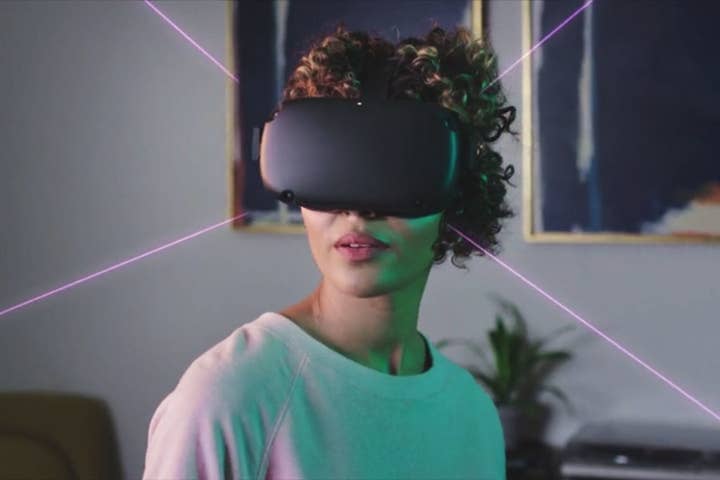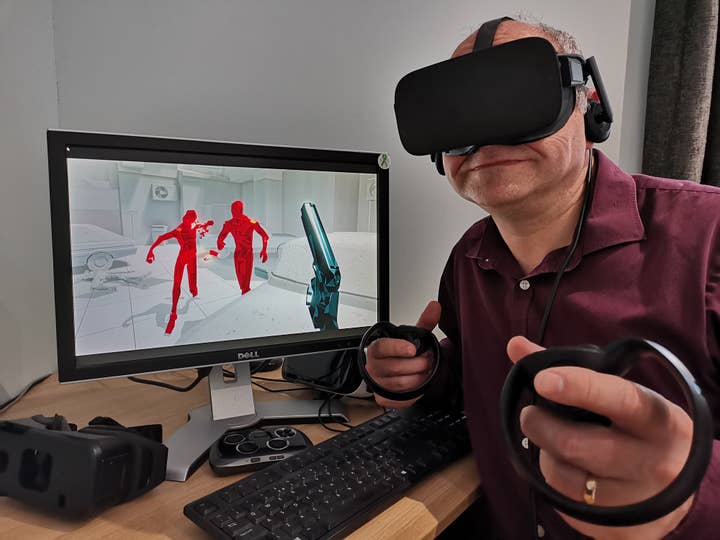Seven years on from Oculus Rift's launch, how far have we come? | Opinion
Game Dragons' Andrew Oliver ponders the current state of virtual reality, and how it might benefit from 5G and streaming
Video games are about immersion, and virtual reality is the embodiment of total immersion in new and exciting worlds.
My first experience -- Battlezone in 1980 -- felt incredible, although in reality it just showed two identical views into a simple 3D vector world.
VR had a few revivals. The 1990s saw the Arcade Virtuality Systems, and in 1995 Nintendo's Virtual Boy promised a lot but sadly didn't deliver. It wasn't until 2012, with Oculus' landmark Kickstarter campaign breaking records and promising affordable, high-quality VR using mobile phone technology, that it felt that virtual reality's time had come.
My involvement with deeper immersive technology started in 2009, when at Blitz Games we decided to create the world's first 3D console game, Invincible Tiger on PS3 and Xbox 360. This came about after we received a prototype TV from Samsung following a conversation at CES about 3D stereoscopic movies.
"VR (and AR) are still struggling in the marketplace, even though yet the hardware issues have mostly been resolved"
Sadly, 3D TVs are no longer made, even though there is now great content and OLED polarised TVs have really perfected the tech. With fixed separation of two images, varying screen sizes are an issue, and there's always the danger of losing those glasses.
I attended the VRX conference in Amsterdam recently, keen to see how VR/AR was progressing. It's five years since I got my original Oculus Rift and I've had various others since. VR and AR had a number of well documented technical hurdles in both hardware and software, but I always felt these were all were solvable, given enough time, money and skills innovation. We needed:
- More comfortable movement through virtual worlds
- High resolution screens with higher refresh rates
- To not be tethered to powerful PCs
- Six degrees of freedom (6DOF), accurate rotation and translation of motion detection with undetectable tags
- Light and slimline headsets/glasses
- Comfortable and intuitive controllers
- High fidelity real time graphics
As well as all of that, the hardware needed to be reasonably priced, with a great catalogue of games and experiences available too. The last seven years have seen many advancements, but VR (and AR) are still struggling in the marketplace, even though the hardware issues have mostly been resolved.
- 2K+ OLED screens capable of refresh rates of 90fps are now the minimum spec and have resolved screen concerns
- New types of controllers have great freedom of movement and feel intuitive
- Headsets now all have 'inside/out' technologies allowing full, accurate 6DOF without the need for cameras or sensors around the room
- Systems are moving away from being tethered to PCs
- Eye tracking is now being experimented with inside headsets, so that the rendered image can more accurately focus on where your eyes are looking (currently everything is in focus and that's not how the human eye really works)

AR has the issue of the small field of view, but this is well recognised and is being addressed -- Hololens 2's main claim is "a larger field of view." It's still not a complete field of view, and this is clearly a very difficult technical challenge.
What about the software?
In the console space, when a manufacturer brings out a new console, they always have a few killer apps -- games that you want so much you'd buy the console for it. The VR market lacks these killer apps, and therefore it's difficult to find a compelling reason to buy a headset.
There are a good number of high quality games now, like Robo Recall, Beat Saber, SuperHot, Angry Birds and so on. Developers have found that 'cockpit games' work very well, and I Expect you to Die makes excellent use of escape room style puzzles, but with the player 'locked' into a chair. Elite Dangerous feels much more immersive in VR than its PC counterpart, and Battlezone is also making a welcome return now in full VR.
Looking to the future
People have been saying since 2012 or earlier that this technology is "only a few years away." It still feels like it's a few years from hitting mass popularity, if it ever does. The Latest research suggests 2021/22.
"Streaming VR content will unfragment the market, as the best quality content can be developed once for the server to stream to any type of headset"
There are now extra issues to contend with. It has become a fragmented market, and without killer apps there's no obvious reason to purchase one headset over another; and there's always the temptation to wait for new, better hardware.
One thing that could help adoption of VR and AR is cloud streaming technologies like Stadia. This removes the hefty processors (which in turn have weighty, expensive batteries) and would enable high-fidelity, real-time graphics to come into lightweight, cheap headsets or glasses. Lag is a potential issue here, but if the stream sends an image larger than the display area, then the head movements can be mapped directly into that rendered scene with virtually no perceived lag at all.
Volumetric video (a technology that allows you to move through a live action movie) is an incredibly exciting area, and the demos are very impressive. Even the most powerful desktops struggle with the amount of data and processing required, but streaming the results from powerful servers can make this a reality.
Stereo 360 video seems quite elusive -- it's typically one or the other, but ideally VR needs both. Whilst it is a huge challenge for Hollywood to create these immersive volumetric movies, the fact that CG movies are entirely inside the computer and the new superhero movies are virtually all 3D composited is taking us in the right direction.
5G is rolling out soon, promising higher bandwidths and less latency. Streaming VR content will also unfragment the market, as the best quality content can be developed once for the server to stream to any type of headset -- maybe even back to simpler devices like your mobile phone, with a Google Cardboard or Gear VR style headset.

AR has so far been separated from VR, with different headsets from different companies, although much of the tech is the same. The obvious exception is the lens, and AR and VR focus on different experiences as a result. A far easier sell for the mass market would be a headset that can do both, with the consumer getting comfortable with AR, before being completely immersed in VR. This would also reduce the fragmentation in the market. Developers (and in some games, players) could decide how much real world they see when viewing a virtual world.
The original tethered headsets tended to have second screens, and these were really helpful for directing someone new in VR, or just experiencing VR more socially. As headsets go untethered we may lose this feature, although I note that Oculus supports Chromecast on Go and Quest. This initially allows that guidance when new people experience VR, but it also allows unique game experiences like Keep Talking and Nobody Explodes, which encourages social play around VR. With streaming technology, other players can also use their screens to see what other players are seeing.
It's not just about games and consumer headsets
Location-based VR is now becoming a recognised business model, with experiences like Ghostbusters and Wreck-it Ralph VR. Museums and heritage locations are using VR to offer immersive experiences of how things used to be. These are a fantastic introduction for casual consumers to see the potential of virtual reality. Location-based VR can add heat, smell and movement to further increase the immersion experience, moving into the Mixed Reality and XR area. This may be how the mass market is introduced to top quality VR experiences, before we get the cheaper more refined headsets for homes.
"Exploring different areas of content [in other industries] within the same technological boundaries may well result in innovative ideas for games"
Hololens and Magic Leap are focusing on the enterprise market. Industries like design, health, education and manufacturing are all waking up to the potential of VR and AR, seeing the added value potential which justifies the high price of the headsets. While developers generally struggle to make money in the traditional VR game space, the demand for good VR and AR developers in industry is huge. Developers can explore these possibilities while we wait for mass market adoption of headsets for gaming. Exploring different areas of content within the same technological boundaries may well result in innovative ideas for games also.
Oculus Studio originally created some first party games, which were great and very polished, but they also felt like VR was the novelty overlaid on a traditional video game -- they didn't actually need or exploit VR. This is common with new technology: when game developers made early mobile games they were mainly ports of traditional games, with virtual joysticks and buttons. It was a while before Angry Birds and Candy Crush appeared -- short session, 2D games, designed to exploit the touch screen correctly and suit the conditions in which they were most likely to be played.
The difference was that people didn't need a killer game to buy a smartphone. They were buying the phone anyway for calls, texts, emails, maps, internet and social media, and the games were a simple added extra. VR needs to work much harder to create a market. Oculus is focusing on getting a lot of exclusives to ensure it becomes the first choice for the consumer. Virtual reality is starting to learn what works, with games like Robo Recall and Beat Saber, but the VR games industry needs to produce games that are worth buying the headset for in their own right.
Sony has done exceptionally well creating a must-have title with the recently released Blood & Truth. It's the showcase game that can show how immersive VR can be and a great reason to buy a PSVR -- although in itself the game is undoubtedly a loss leader. It's setting a benchmark that few others can afford to follow.
Virtual and augmented reality still show massive potential in the way they can transport us to virtual worlds, but as Bill Gates said: "We always overestimate the change that will occur in the next two years and underestimate the change that will occur in the next ten". Developers have long seen the potential and the obvious next steps, but the mass market needs reasons to buy the headsets, the games and experiences that will make it worth the cost. I'm confident that it's coming, but how soon?
Andrew Oliver is co-founder of new consultancy firm Game Dragons and one half of the veteran Oliver Twins. This is the latest in a series of columns from Game Dragons offering advice to developers on growing their business. You can read the rest here.
